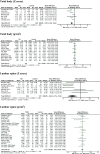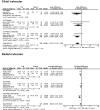Bone Mineral Density and Type 1 Diabetes in Children and Adolescents: A Meta-analysis
- PMID: 34285100
- PMCID: PMC8385468
- DOI: 10.2337/dc20-3128
Bone Mineral Density and Type 1 Diabetes in Children and Adolescents: A Meta-analysis
Abstract
Background: There is substantial evidence that adults with type 1 diabetes have reduced bone mineral density (BMD); however, findings in youth are inconsistent.
Purpose: To perform a systematic review and meta-analysis of BMD in youth with type 1 diabetes using multiple modalities: DXA, peripheral quantitative computed tomography (pQCT), and/or quantitative ultrasound (QUS).
Data sources: PubMed, Embase, Scopus, and Web of Science from 1 January 1990 to 31 December 2020, limited to humans, without language restriction.
Study selection: Inclusion criteria were as follows: cross-sectional or cohort studies that included BMD measured by DXA, pQCT, or QUS in youth (aged <20 years) with type 1 diabetes and matched control subjects.
Data extraction: We collected data for total body, lumbar spine, and femoral BMD (DXA); tibia, radius, and lumbar spine (pQCT); and phalanx and calcaneum (QUS). Weighted mean difference (WMD) or standardized mean difference was estimated and meta-regression was performed with age, diabetes duration, and HbA1c as covariates.
Data synthesis: We identified 1,300 nonduplicate studies; 46 met the inclusion criteria, including 2,617 case and 3,851 control subjects. Mean ± SD age was 12.6 ± 2.3 years. Youth with type 1 diabetes had lower BMD: total body (WMD -0.04 g/cm2, 95% CI -0.06 to -0.02; P = 0.0006), lumbar spine (-0.02 g/cm2, -0.03 to -0.0; P = 0.01), femur (-0.04 g/cm2, -0.05 to -0.03; P < 0.00001), tibial trabecular (-11.32 g/cm3, -17.33 to -5.30; P = 0.0002), radial trabecular (-0.91 g/cm3, -1.55 to -0.27; P = 0.005); phalangeal (-0.32 g/cm3, -0.38 to -0.25; P < 0.00001), and calcaneal (standardized mean difference -0.69 g/cm3, -1.11 to -0.26; P = 0.001). With use of meta-regression, total body BMD was associated with older age (coefficient -0.0063, -0.0095 to -0.0031; P = 0.002) but not with longer diabetes duration or HbA1c.
Limitations: Meta-analysis was limited by the small number of studies with use of QUS and pQCT and by lack of use of BMD z scores in all studies.
Conclusions: Bone development is abnormal in youth with type 1 diabetes, assessed by multiple modalities. Routine assessment of BMD should be considered in all youth with type 1 diabetes.
© 2021 by the American Diabetes Association.
Figures




Similar articles
-
Childhood type 1 diabetes is associated with abnormal bone development.Pediatr Diabetes. 2022 Sep;23(6):773-782. doi: 10.1111/pedi.13367. Epub 2022 Jun 6. Pediatr Diabetes. 2022. PMID: 35603554 Free PMC article.
-
"Which skeletal imaging modality is best for assessing bone health in children and young adults compared to DXA? A systematic review and meta-analysis".Bone. 2021 Sep;150:116013. doi: 10.1016/j.bone.2021.116013. Epub 2021 May 23. Bone. 2021. PMID: 34029779 Review.
-
Cross-sectional and longitudinal evaluation of bone mass and quality in children and young adults with juvenile onset systemic lupus erythematosus (JSLE): role of bone mass determinants analyzed by DXA, PQCT and QUS.Lupus. 2014;23(1):57-68. doi: 10.1177/0961203313511679. Epub 2013 Nov 11. Lupus. 2014. PMID: 24218395
-
Comparisons of noninvasive bone mineral measurements in assessing age-related loss, fracture discrimination, and diagnostic classification.J Bone Miner Res. 1997 May;12(5):697-711. doi: 10.1359/jbmr.1997.12.5.697. J Bone Miner Res. 1997. PMID: 9144335
-
Bone deficits in children and youth with type 1 diabetes: A systematic review and meta-analysis.Bone. 2022 Oct;163:116509. doi: 10.1016/j.bone.2022.116509. Epub 2022 Jul 29. Bone. 2022. PMID: 35914713 Review.
Cited by
-
The Use of Dissolvable Synthetic Calcium Impregnated with Antibiotic in Osteoarticular Infection in Patients with Diabetes.Life (Basel). 2024 Oct 20;14(10):1335. doi: 10.3390/life14101335. Life (Basel). 2024. PMID: 39459635 Free PMC article.
-
Sarm1 knockout prevents type 1 diabetic bone disease in females independent of neuropathy.JCI Insight. 2024 Jan 4;9(4):e175159. doi: 10.1172/jci.insight.175159. JCI Insight. 2024. PMID: 38175722 Free PMC article.
-
Recent progress in bone-repair strategies in diabetic conditions.Mater Today Bio. 2023 Oct 20;23:100835. doi: 10.1016/j.mtbio.2023.100835. eCollection 2023 Dec. Mater Today Bio. 2023. PMID: 37928253 Free PMC article. Review.
-
Trabecular bone score in adults with type 1 diabetes: a meta-analysis.Osteoporos Int. 2024 Jan;35(1):105-115. doi: 10.1007/s00198-023-06935-z. Epub 2023 Oct 11. Osteoporos Int. 2024. PMID: 37819402
-
Association between fatty acids intake and bone mineral density in adults aged 20-59: NHANES 2011-2018.Front Nutr. 2023 Mar 17;10:1033195. doi: 10.3389/fnut.2023.1033195. eCollection 2023. Front Nutr. 2023. PMID: 37102128 Free PMC article.
References
-
- Morrison LB. Bogan IK. Bone development in diabetic children; roentgen study. Am J Med Sci 1927;274:313–319
-
- Shah VN, Harrall KK, Shah CS, et al. . Bone mineral density at femoral neck and lumbar spine in adults with type 1 diabetes: a meta-analysis and review of the literature. Osteoporos Int 2017;28:2601–2610 - PubMed
-
- Janghorbani M, Van Dam RM, Willett WC, Hu FB. Systematic review of type 1 and type 2 diabetes mellitus and risk of fracture. Am J Epidemiol 2007;166:495–505 - PubMed
Publication types
MeSH terms
Associated data
LinkOut - more resources
Full Text Sources
Other Literature Sources
Medical
Miscellaneous


